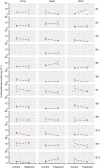Are individuals consistent? Endocrine reaction norms under different ecological challenges
- PMID: 34142697
- PMCID: PMC8246341
- DOI: 10.1242/jeb.240499
Are individuals consistent? Endocrine reaction norms under different ecological challenges
Abstract
Quantifying organismal capacity for compensatory mechanisms is essential to forecast responses to environmental change. Despite accumulating evidence for individual variation in physiological plasticity, the causes and consequences of this variation remain unclear. An outstanding question is whether individual reaction norms are consistent across different environmental challenges, i.e. whether an individual that is responsive to one environmental variable will be equally responsive to a different environmental variable. Additionally, are these reaction norms themselves consistent over time, i.e. repeatable? Here, we quantified individual baseline glucocorticoid responses in house sparrows, Passer domesticus, to sequential manipulations of temperature, wind speed and food unpredictability that were repeated in discrete blocks of sampling under both control and stressor-exposed conditions. Individuals significantly decreased their baseline corticosterone levels and increased their mass during treatment exposure. This response was consistent across environmental challenge types. There was high repeatability in the intercept and slope of the baseline corticosterone reaction norm between environmental challenges but broad credible intervals in the repeatability of the reaction norm slope, suggesting that although glucocorticoid levels during baseline conditions are repeatable, among-individual variation in the shape of the glucocorticoid response may be higher than within-individual variation. Within-subject variation in baseline corticosterone levels was mainly explained by within-individual variation in body mass during stressor exposure. Despite the high lability in physiological traits, endocrine plasticity is repeatable across environmental challenges and may be able to evolve as a result of genetic accommodation, in which selection acts on genetic variation of reaction norms.
Keywords: Corticosterone; Food unpredictability; Glucocorticoids; House sparrows; Temperature; Wind.
© 2021. Published by The Company of Biologists Ltd.
Conflict of interest statement
Competing interests The authors declare no competing or financial interests.
Figures






References
-
- Anderson, D. R. and Burnham, K. P. (2002). Avoiding pitfalls when using information-theoretic methods. J. Wildl. Manage. 66, 912-918.
-
- Araya-Ajoy, Y. G., Mathot, K. J. and Dingemanse, N. J. (2015). An approach to estimate short-term, long-term and reaction norm repeatability. Methods Ecol. Evol. 6, 1462-1473. 10.1111/2041-210X.12430 - DOI
-
- Bates, D., Mächler, M., Bolker, B. and Walker, S. (2015). Fitting linear mixed-effects models using lme4. J. Stat. Softw. 67, 48. 10.18637/jss.v067.i01 - DOI
Publication types
MeSH terms
Substances
Grants and funding
LinkOut - more resources
Full Text Sources

